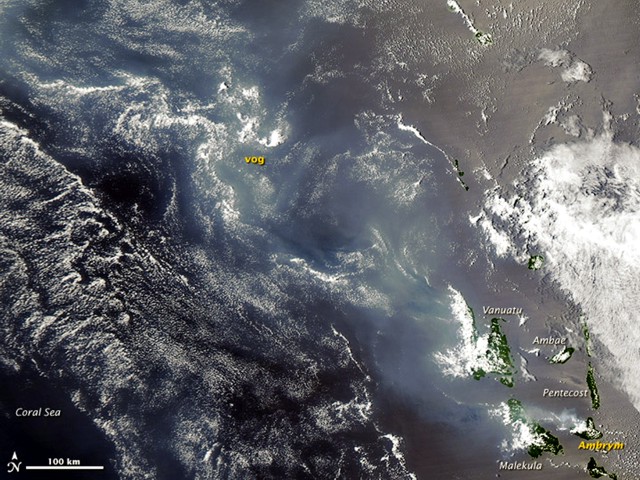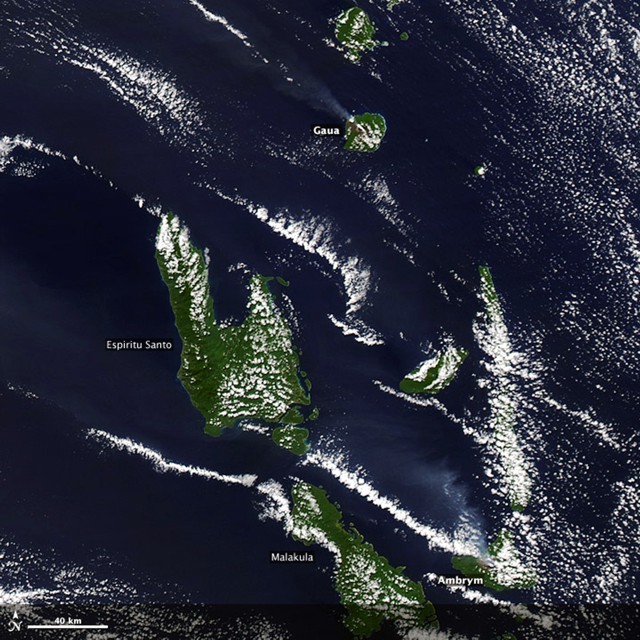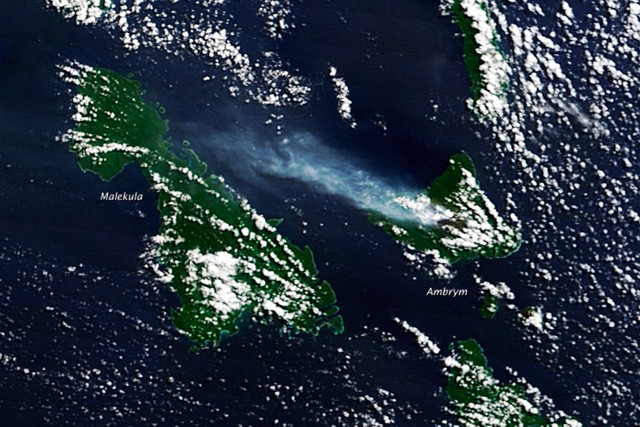Report on Ambrym (Vanuatu) — May 2011
Bulletin of the Global Volcanism Network, vol. 36, no. 5 (May 2011)
Managing Editor: Richard Wunderman.
Ambrym (Vanuatu) Ongoing plumes, some bearing ash and to over 6 km altitude
Please cite this report as:
Global Volcanism Program, 2011. Report on Ambrym (Vanuatu) (Wunderman, R., ed.). Bulletin of the Global Volcanism Network, 36:5. Smithsonian Institution. https://doi.org/10.5479/si.GVP.BGVN201105-257040
Ambrym
Vanuatu
16.25°S, 168.12°E; summit elev. 1334 m
All times are local (unless otherwise noted)
In our last report on Ambrym (BGVN: 3411), we described the frequent thermal anomalies from the volcano's active lava lakes during October 2008-September 2009. Satellite imagery in 2009 and 2010 suggested ongoing visible plumes and thermal alerts consistent with active lava lakes. Several satellite images of Vanuatu appear below (figures 21-22).
Based on observations by aircraft pilots, analyses of satellite imagery, and information from the Vanuatu Geohazards Observatory (VGO), the Wellington Volcanic Ash Advisory Center (VAAC) reported that on 8 and 10 August 2010 ash and steam plumes from Ambrym volcano rose to an altitude 6.1 km and drifted W and NW.
Ambrym is a major source of SO2 in the Vanuatu Republic. The VGO web site shows daily Vanuatu volcanic sulfur dioxide (SO2) fluxes through a partnership with GNS Science Institute (Taupo, New Zealand) using OMI satellite images.
Figure 23 shows a 22 May 2011 satellite image of Ambrym. Similar images were acquired by NASA satellites on 28 March 2011 and on 7 June 2011. On figure 23, a blue-tinged volcanic plume emissions extends from Ambrym to the W. The plume contains vog, a mix of gases and aerosols that is formed when SO2 and other volcanic gases react with sunlight, oxygen, and moisture.
Geological Summary. Ambrym, a large basaltic volcano with a 12-km-wide caldera, is one of the most active volcanoes of the New Hebrides Arc. A thick, almost exclusively pyroclastic sequence, initially dacitic then basaltic, overlies lava flows of a pre-caldera shield volcano. The caldera was formed during a major Plinian eruption with dacitic pyroclastic flows about 1,900 years ago. Post-caldera eruptions, primarily from Marum and Benbow cones, have partially filled the caldera floor and produced lava flows that ponded on the floor or overflowed through gaps in the caldera rim. Post-caldera eruptions have also formed a series of scoria cones and maars along a fissure system oriented ENE-WSW. Eruptions have apparently occurred almost yearly during historical time from cones within the caldera or from flank vents. However, from 1850 to 1950, reporting was mostly limited to extra-caldera eruptions that would have affected local populations.
Information Contacts: Vanuatu Geohazards Observatory, Department of Geology, Mines and Water Resources of Vanuatu (URL: http://www.vmgd.gov.vu/vmgd/); NASA Earth Observatory (URL: http://earthobservatory.nasa.gov/); MODIS/MODVOLC Thermal Alerts System, Hawai'i Institute of Geophysics and Planetology (HIGP), School of Ocean and Earth Science and Technology (SOEST), Univ. of Hawai'i, 2525 Correa Road, Honolulu, HI 96822, USA (URL: http://modis.higp.hawaii.edu/); Wellington Volcanic Ash Advisory Centre (VAAC), Meteorological Service of New Zealand Ltd (MetService), PO Box 722, Wellington, New Zealand (URL: http://www.metservice.com/vaac/, URL: http://vaac.metservice.com/).




